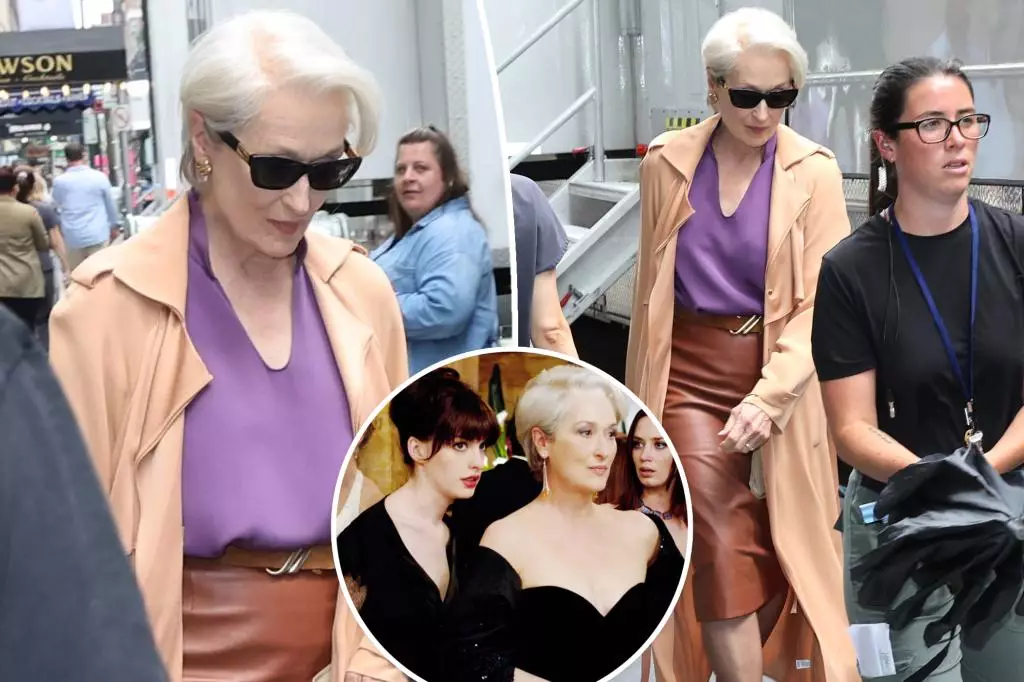The recent filming of “The Devil Wears Prada 2” marks a significant milestone in contemporary popular culture, not merely because it’s a sequel to a beloved film from 2006, but because it signifies the enduring influence of fashion, power dynamics, and cultural commentary. At the heart of this resurgence is Meryl Streep’s portrayal of Miranda Priestly—a character who has become an archetype of command, sophistication, and icy professionalism. Her front-and-center return signals a reclaiming of this persona’s prominence and an acknowledgment of its relevance in today’s evolving media landscape.
The image of Streep embodying Miranda with her signature platinum pixie cut and polished chic attire is more than a nod to nostalgia; it’s a statement about resilience and authority. In a world increasingly obsessed with change and adaptation, the consistency of such a character underscores the power of style, poise, and uncompromising ambition. The sequel’s timing might be coincidental, but it resonates with broader societal currents—our fascination with leadership, influence, and the personas we project. The return of Miranda Priestly is a bold reminder that true power endures, often cloaked in elegance.
The Cultural Implications of the Returning Cast and New Faces
This film’s ensemble cast expansion, including Anne Hathaway, Emily Blunt, and Stanley Tucci, alongside fresh faces like Kenneth Branagh, Lucy Liu, and Justin Theroux, encapsulates a blend of continuity and reinvention. Hathaway’s nostalgic nod to the original’s iconic cerulean sweater – a deliberate callback to the film’s visual language – speaks to a cultural obsession with symbolism and detail. Her character, Andy Sachs, represents the outsider’s journey into a world dominated by high-stakes fashion and power; her evolving wardrobe choices reflect her navigation through this terrain.
The inclusion of new characters and prominent actors hints at an injection of fresh narratives and vistas into the fashion industry’s hyperreal universe. Kenneth Branagh’s casting as Miranda Priestly’s husband suggests an exploration of her personal life and vulnerabilities—elements often hidden behind her polished façade. Lucy Liu, Justin Theroux, and B.J. Novak bring diverse perspectives that are likely to challenge or complement the established dynamics, signaling a narrative that balances legacy with innovation.
This shifting cast composition—marrying familiarity with novelty—demonstrates the industry’s recognition that stories about power, ambition, and style remain compelling when filtered through new eyes. Moreover, the film’s release in 2026 coincides with a cultural moment ripe for reflections on gender roles, aging, and authority in the media landscape.
The Intersection of Fashion, Personal Identity, and Cultural Commentary
Meryl Streep’s candid reflections on her previous discomfort with embodying Miranda Priestly reveal an intriguing layer about performance and authenticity. Her admission that portraying such a formidable character was “horrible” and “depressing” underscores the emotional toll of inhabiting a persona of power. Yet, her eventual embrace highlights an evolution—an understanding that the mask of authority can be both a burden and a badge of resilience.
Fashion here acts as a symbolic armor—evident in her calculated wardrobe choices, from the icy white pixie cut to the tailored trench coat. These visual markers reinforce the idea that elegance and intimidation are often two sides of the same coin. As modern viewers, we are increasingly aware that these images are not just about aesthetics but serve as a commentary on societal expectations of women in power. The sequel’s return to this theme—through both costume design and character development—reflects a cultural shift toward recognizing strength as multifaceted, not solely defined by traditional softness or femininity.
Hathaway’s ongoing on-set style evolution also emphasizes this point. Her playful yet sophisticated wardrobe selections symbolize the fluidity of identity within the industry—a reminder that fashion is a language, a statement of autonomy amidst external pressures. As these characters navigate their worlds, they challenge viewers to reconsider notions of leadership, influence, and authenticity.
Final Thoughts: The Power of Reimagining Classics
The anticipation surrounding “The Devil Wears Prada 2” signifies more than a mere commercial sequel; it embodies a cultural re-examination of power, style, and resilience. By bringing back foundational characters and introducing new ones who push the narrative forward, the film promises to explore contemporary issues within the glamorous yet cutthroat fashion universe. Beyond the surface spectacle, it invites us to reflect on the enduring allure of authority dressed in polished sophistication. To understand this film is to recognize that its true power lies in challenging stereotypes, celebrating complexity, and reaffirming that strength often resides in grace under pressure.

